Marie Curie
From Wikipedia, the free encyclopedia
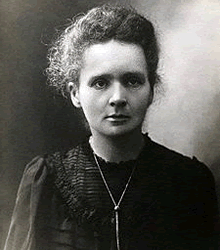
Maria Sk?odowska-Curie.
Born November 7, 1867(1867-11-07)
Warsaw, Vistulan Country, Russian Empire
Died July 4, 1934 (aged 66)
Sancellemoz, France
Nationality Poland, France
Fields Physics, Chemistry
Institutions University of Paris
Alma mater University of Paris
ESPCI
Doctoral advisor Henri Becquerel
Doctoral students André-Louis Debierne
Marguerite Catherine Perey
Known for Radioactivity
Notable awards Nobel Prize in Physics (1903)
Davy Medal (1903)
Matteucci Medal (1904)
Nobel Prize in Chemistry (1911)
Notes
The only person to win two Nobel Prizes in different science fields.
Marie Curie (born Maria Sk?odowska; also known as Maria Sk?odowska-Curie; November 7, 1867 – July 4, 1934) was a physicist and chemist of Polish upbringing and, subsequently, French citizenship. She was a pioneer in the field of radioactivity, the first and only person honored with Nobel Prizes in two different sciences, and the first female professor at the University of Paris.
She was born in Warsaw, Vistula Country, Russian Empire, and lived there until she was 24. In 1891 she followed her elder sister Bronis?awa to study in Paris, where she obtained her higher degrees and conducted her scientific work. She founded the Curie Institutes in Paris and Warsaw. She was the wife of fellow-Nobel-laureate Pierre Curie and the mother of a third Nobel laureate, Irène Joliot-Curie.
While an actively loyal French citizen, she never lost her sense of Polish identity. Madame Curie named the first new chemical element that she discovered (1898) "polonium" for her native country,[1] and in 1932 she founded a Radium Institute (now the Maria Sk?odowska-Curie Institute of Oncology) in her home town, Warsaw, headed by her physician-sister Bronis?awa.
*
Life
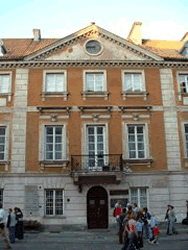
Maria Sk?odowska's birthplace on ulica Freta (Freta Street) in Warsaw's "New Town."
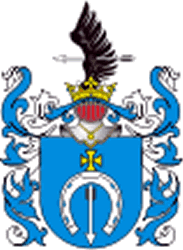
Do??ga coat-of-arms, hereditary in Sk?odowska's family
Maria Sk?odowska was born in Warsaw to Bronis?awa and W?adys?aw Sk?odowski, impoverished teachers who could barely make ends meet[2] but who instilled in their children a sense of the value of learning. The father, W?adys?aw, taught mathematics and physics, subjects that his daughter was to pursue. On both the paternal and maternal sides, the family had lost their property and fortunes through patriotic involvements in Polish national uprisings. This condemned each subsequent generation, including that of Maria and her elder sisters and brother, to a difficult struggle to get ahead in life.[3]
Maria was the youngest of five children: Zofia (born 1862), Józef (1863), Bronis?awa (1865), Helena (1866) and finally Maria (1867).
Maria's early years were marked by the death of her sister Zofia from typhus and, two years later, the death of her courageous, hard-working mother from tuberculosis. These events caused Maria to give up her Roman Catholic religion and become agnostic.[4]
From childhood Sk?odowska showed a phenomenal memory and capacity for concentration, an exceptionally quick mind, and extraordinary diligence; she was known to neglect food and sleep in order to study. She also showed a certain predisposition to depressions, which would recur later in life.[5] At age sixteen she graduated at the top of her class from a Russian liceum, winning a gold medal.
Because she was female, and because of Russian reprisals following the Polish 1863 uprising against Tsarist Russia, Sk?odowska was denied admission to a regular university. Her father having lost his savings through bad investments, Maria had to take work as a teacher while attending Warsaw's illegal Polish Flying University.
At age 18 she took a post in Ciechanów as a governess to a wealthy landed family, the ?órawskis. During her nearly four years there, far from home, Maria experienced isolation, life among strangers, abasement as a governess, and finally her first, joyous but also painful, love, which left her with a deep sense of humiliation. Her pupil Kazimierz ?órawski, after going to Warsaw to study, realized the attraction that he had felt to his tutor, who radiated intelligence and a vivacious girlish charm. But his parents disapproved of any plans that he might have harbored of marrying the penniless girl, and Kazimierz wanted no conflict with his parents.[6]
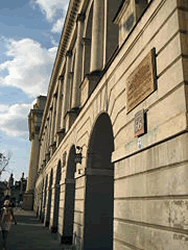
Krakowskie Przedmie?cie 66, near Warsaw's Old Town (in the distance). At a lab here, in 1890–91, Maria Sk?odowska did her first scientific work.
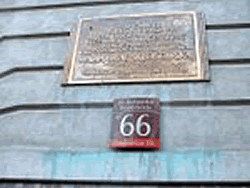
Plaque commemorating Sk?odowska's first scientific work, in a physics laboratory directed by J.J. Boguski, at Warsaw's Museum of Industry and Agriculture
Maria returned to Warsaw, pursued her education, worked in a laboratory on historic Krakowskie Przedmie?cie, and dreamed of going to Paris, France, where her sister Bronis?awa was finishing her medical studies, financed partly with Maria's savings. Maria continued her long-distance romance with Kazimierz, who eventually went to Zakopane, where Maria was visiting, to be alone with her again. Mania, though smitten with him, stuck by her guns, rejecting all proposals short of marriage.[7]
Their subsequent break-up proved tragic for both. Kazimierz ?órawski soon earned his doctorate and pursued an academic career as a mathematician, becoming a professor and rector of Kraków University and president of the Warsaw Society of Learning. He of course followed Maria's stunning scientific career. Anecdotes would describe him, in old age, often sitting beneath her monument on Warsaw's Wawel Street (ulica Wawelska) before the Radium Institute that had been founded by double Nobel laureate Maria Sk?odowska–Curie ("Madame Curie").[8]
Maria Sk?odowska in 1891, after the break-up, went back to her old idea of studying in Paris, where her sister had completed medical school and gotten married. Maria found shelter with her sister and was soon one of only twenty-odd women among two thousand students of the exact sciences at the Sorbonne (the University of Paris). Though at first behind her classmates in some areas, she soon caught up.[9]
At the Sorbonne, Sk?odowska studied mathematics, physics and chemistry. (Later, in 1909, she would become that University's first female professor, when she was named to her late husband's chair in physics, which he had held for only a year and a half before his tragic death.) In early 1893 she graduated first in her undergraduate class. A year later, also at the Sorbonne, she obtained her master's degree in mathematics.
It was then that Pierre Curie entered her life. He was an instructor in the School of Physics and Chemistry, the École Supérieure de Physique et de Chimie Industrielles de la Ville de Paris (ESPCI). Sk?odowska had begun her scientific career in Paris with an investigation of the magnetic properties of various steels; it was their mutual interest in magnetism that drew Sk?odowska and Curie together.[10] He soon realized that in Sk?odowska he had met a genius.[11]
Her departure for the summer to Warsaw only enhanced their mutual feelings for each other. She was still laboring under the illusion that she would be able to return to Poland and work in her chosen field of study. When, however, she was denied a place at Kraków University merely because she was a woman, she returned to Paris. Not fully a year later, in 1895, she and Pierre Curie married, and thereafter the two physicists hardly ever left their laboratory. Their one shared recreation was long bicycle trips and journeys abroad, which brought them even closer. Maria had found a new love, a partner and scientific collaborator that she could depend on.[12]
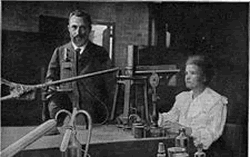
Pierre and Marie Curie in their Paris lab before April 19, 1906 (when he died).
Eventually they studied radioactive materials, particularly pitchblende, the complex mineral from which uranium was extracted. By April 1898, Sk?odowska–Curie deduced that pitchblende must contain traces of an unknown substance far more radioactive than uranium. In July 1898, Pierre and Marie together published an article announcing the existence of an element which they named "polonium," in honor of her native Poland, then still partitioned among three empires. On December 26, 1898, the Curies announced the existence of a second element, which they named "radium" for its intense radioactivity — a word that they coined.
Over the course of four years of the most arduous work in the most difficult physical conditions, they processed a ton of pitchblende, eventually in 1902 isolating one-tenth of a gram of radium chloride. By 1910 Marie, working on without her husband, who had been killed in 1906, would isolate the pure radium metal. In an unusual decision, Sk?odowska-Curie intentionally refrained from patenting the radium-isolation process so that the scientific community could do research unhindered.
Marie and Pierre had no idea what price was to be paid for chronic exposure to radioactive substances.[13]
In 1903, under the supervision of Henri Becquerel, Marie received her DSc from the University of Paris, becoming the first woman in France to complete a doctorate.
Marie also saw to it that Pierre completed his own long-deferred doctorate. At the time, a witticism circulated that "Pierre's greatest discovery was Maria, and then she discovered radioactivity." [14]
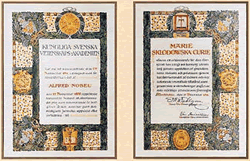
Maria Sk?odowska–Curie's 1911 Nobel Prize diploma
In 1903, the Royal Swedish Academy of Sciences awarded Pierre Curie, Marie Curie, and Henri Becquerel the Nobel Prize in Physics, "in recognition of the extraordinary services they have rendered by their joint researches on the radiation phenomena discovered by Professor Henri Becquerel."
Maria and Pierre were unable to go to Stockholm in person to receive the prize. They immediately, however, shared its financial proceeds with needy persons and acquaintances, including students.[15]
Sk?odowska–Curie was the first woman to be awarded a Nobel Prize. Eight years later, she would receive the 1911 Nobel Prize in Chemistry, "in recognition of her services to the advancement of chemistry by the discovery of the elements radium and polonium, by the isolation of radium and the study of the nature and compounds of this remarkable element."
A month after accepting her 1911 Nobel Prize, she was hospitalized with depression and a kidney ailment.
Sk?odowska–Curie was the first person to win or share two Nobel Prizes. She is one of only two people who have been awarded a Nobel Prize in two different fields, the other being Linus Pauling (Chemistry, Peace). She remains the only woman to have won two Nobel Prizes, and the only person to have won Nobel Prizes in two different science fields. Nevertheless, the French Academy of Sciences refused to abandon its prejudice against women, and she failed by one vote to be elected to membership.[16] It would be her doctoral student, Marguerite Perey, who would be the first woman elected to the Academy — in 1962, over half a century after Pierre Curie's 1905 election.
On April 19, 1906, Pierre was killed in a street accident as he was leaving a publisher's office. He had gone there to review proofs of an article, and found the business closed due to a strike. Heading back across the street in heavy rain, he was struck by a horse-drawn vehicle and fell under its wheels, fracturing his skull. While it has been speculated that he may previously have been weakened by prolonged radiation exposure, it has not been proven that this was the cause of the accident.
Marie was devastated by her husband's death. She noted that as of that moment she had suddenly become "an incurably and wretchedly lonely person." Nevertheless, she courageously undertook to carry on at the Sorbonne the physics course that Pierre had been teaching, and she sought in her exhausting work regime a meaning for her life. Paradoxically, recognition for her work now grew to a crescendo, and in 1911 the Royal Swedish Academy of Sciences awarded her her second Nobel Prize. A delegation of celebrated Polish men of learning, headed by world-famous novelist Henryk Sienkiewicz, besought her to return to Poland and continue her research in her native country.[17]
After Pierre's death, Marie may have had an affair with physicist Paul Langevin[— a married man who had left his wife — which resulted in a press scandal, exploited by her academic opponents. Despite her fame as a scientist working for France, the public's attitude to the scandal tended toward xenophobia. Later, Langevin's grandson Michel Langevin would marry Sk?odowska-Curie's granddaughter, Hélène Joliot.
During World War I, Sk?odowska-Curie pushed for the use of mobile radiography units, which came to be popularly known as petites Curies ("Little Curies"), for the treatment of wounded soldiers. These units were powered using tubes of radium emanation, a colorless, radioactive gas given off by radium, later identified as radon. Sk?odowska-Curie personally provided the tubes, derived from the radium she purified. Also, promptly after the war started, she donated her and her husband's gold Nobel Prize medals for the war effort.
After World War I, in 1921 and again in 1929, Sk?odowska-Curie toured the United States, where she was welcomed triumphantly, to raise funds for research on radium. These distractions from her scientific labors, and the attendant publicity, caused her much discomfort but provided resources for her work. Her second American tour succeeded in equipping the Warsaw Radium Institute, founded in 1925, with her sister Bronis?awa as director.
In her later years, Sk?odowska-Curie headed the Pasteur Institute and a radioactivity laboratory created for her by the University of Paris.
Sk?odowska–Curie visited Poland a last time in the spring of 1934.[18] Only a couple of months later, she was dead. Her death near Sallanches, Savoy, in 1934 was from aplastic anemia, almost certainly due to exposure to radiation. The damaging effects of ionizing radiation were then not yet known, and much of her work had been carried out in a shed with no safety measures. She had carried test tubes containing radioactive isotopes in her pocket and stored them in her desk drawer, remarking on the pretty blue-green light that the substances gave off in the dark.
She was interred at the cemetery in Sceaux, where Pierre lay, but sixty years later, in 1995, in honor of their work, the remains of both were transferred to the Panthéon in Paris. Her laboratory is preserved in the Musée Curie.
The Curies' elder daughter, Irène Joliot-Curie, won a Nobel Prize for Chemistry in 1935 for discovering that aluminum could be radioactive and emit neutrons when bombarded with alpha rays. The younger daughter, Ève Curie, wrote the biography, Madame Curie, after her mother's death.
Prizes
* Nobel Prize in Physics (1903)
* Davy Medal (1903)
* Matteucci Medal (1904)
* Nobel Prize in Chemistry (1911)
Tributes
As one of the most famous female scientists to date, Marie Curie has been an icon in the scientific world and has inspired many tributes and recognitions. In 1995, she was the first and only woman laid to rest under the famous dome of the Panthéon, in Paris, on her own merits, alongside her husband. The curie (symbol Ci), a unit of radioactivity, is named in her and/or Pierre's honour,[19][20] as is the element with atomic number 96 - curium.
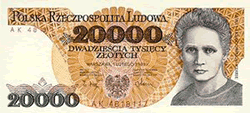
Polish 20,000-old-z?oty banknote with likeness of Maria Sk?odowska-Curie
Sk?odowska-Curie's likeness appeared on the Polish late-1980s inflationary 20,000-z?oty banknote. Her likeness also appeared on stamps and coins, and on the last French 500-franc note, with her husband, before the franc was made obsolete by the euro.
Greer Garson and Walter Pidgeon starred in the 1943 U.S. Oscar-nominated film, Madame Curie, based on her life. "Marie Curie" is also the name of a character in a 1988 comedy, Young Einstein, by Yahoo Serious.
Three radioactive minerals are named after the Curies: curite, sklodowskite, and cuprosklodowskite.
Pierre and Marie Curie University, the largest science, technology and medicine university in France, and successor institution to the faculty of science at the University of Paris, where she taught, is named in honor of her and Pierre. The university is home to the laboratory where they discovered radium.
Another school named for her, Marie Curie M.S. 158, in Bayside, Queens, New York, specializes in science and technology; as does Curie Metropolitan High School — located in Archer Heights, on Chicago's Southwest Side — which has a Technical, Performing Arts and IB program.
In 2007, the Pierre Curie Paris Métro station was renamed the "Pierre et Marie Curie" station.
The Maria Sk?odowska-Curie Medallion, a stained-glass panel created by Jozef C. Mazur, may be found at the University at Buffalo Polish Room.
A KLM McDonnell Douglas MD-11 (registration PH-KCC) is named in her honor.[21]
See also
* Maria Curie-Sk?odowska University in Lublin
* Maria Sk?odowska-Curie Institute of Oncology in Warsaw
* Curie Institute and Curie Museum in Paris
* List of people on stamps of Ireland
* Marie Curie Cancer Care
* Curie